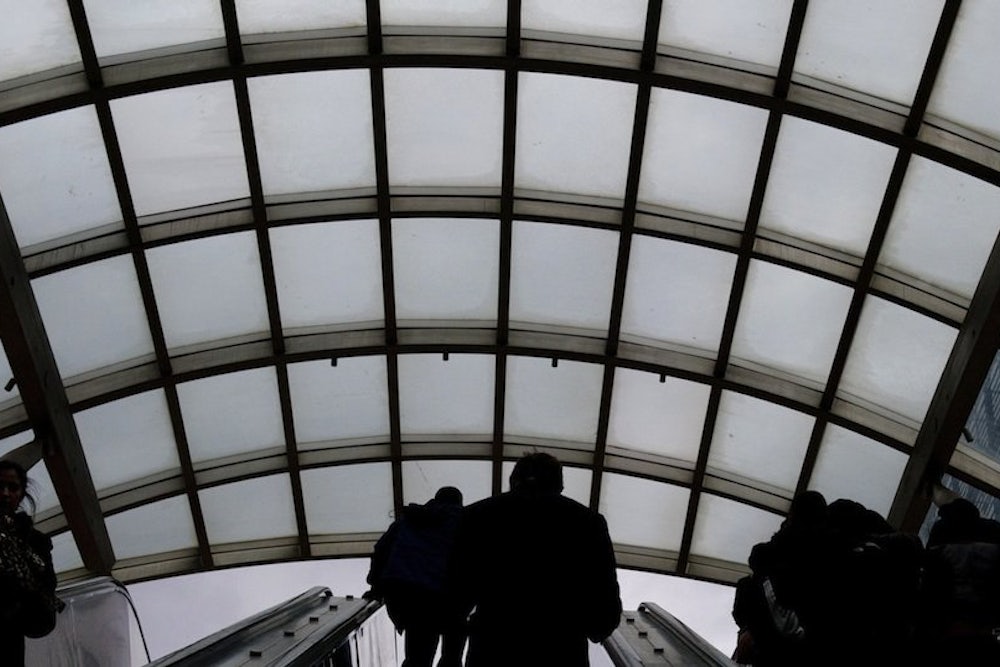It’s been a rough week for the much-touted urbanization of the Washington DC suburbs. As much as any place in the country, they have emerged as a major test of whether municipalities can redeem the planning and development sins of the second half of the 20th century. "Remaking America's sprawling suburbs, with their enormous footprints, shoddy construction, hastily built infrastructure and dying malls, is shaping up to be the biggest urban revitalization challenge of modern times,” declared urbanist guru Richard Florida in 2010.
But then came word on Monday that the extension of the Washington Metro to Tysons Corner, Virginia—the first leg of an extension all the way to Dulles Airport—has not yet transformed the car-dependent, soul-numbing edge city into a walkable, vibrant downtown, as its planners were hoping. The Tysons Corner stations haven’t even officially opened—the first Silver Line train won’t disgorge passengers until late this year—but already plans are being tweaked to include “temporary ‘pop-up’ development to make stations feel less desolate,” according to The Washington Post:
The county has just begun implementing a 40-year plan to remake Tysons Corner from a sprawling, traffic-clogged sea of office buildings, parking lots and shopping malls into an urban downtown where more people live. The Metro stops are a central part of that plan, but until Tysons urbanizes, the areas around them won’t be especially pedestrian friendly. The future Greensboro station, for example, located on Leesburg Pike, is in the middle of a six-lane highway. One side is flanked by a strip mall, and the other by a vacant lot, a mattress store and a shop that advertises “late night DVDs.” The McLean and Tysons Corner stops are in the middle of 10 lanes of traffic, surrounded mostly by corporate offices and parking lots. Pending redevelopment plans will largely remake Tysons, but in the meantime, Fairfax is looking into pop-up businesses and other temporary infrastructure to orient riders, create a sense of place and help set the stage for what the county hopes Tysons will become — a vibrant, walkable destination.
The county will be assisted in this effort by 13 students from nearby George Mason University, who are tasked with recommending for the vacant lots near stations proposals involving food trucks, fairs and "short-term businesses in temporary retail and restaurant space built out of shipping containers." Truly, nothing says bright lights, big city like Potemkin retail in shipping containers designed by a handful of 20-year-olds!
Meanwhile, across the Potomac, the Post reports that things are also not going so well with the ongoing effort to remake another edge city, Silver Spring, into a hip hub:
A series of design and construction failures—including inadequate concrete strength and a lack of reinforcing steel—have left the Silver Spring Transit Center unsafe and unusable without major repairs, Montgomery County officials said Tuesday. The problems go far beyond what was previously known and will keep the opening of the $112 million bus-and-train hub, already two years behind schedule, on hold indefinitely. Officials could not say how much it would cost to fix the issues or who would be liable.
…The findings are an embarrassing setback for the county in its efforts to transform Silver Spring into a genuine urban center, one less dependent on automobiles. The concrete structure at Colesville Road and Wayne Avenue, formally known as the Paul S. Sarbanes Transit Center, is envisioned as a central hub for buses, Metrorail, MARC trains, cabs and bikes.
I passed through the existing Silver Spring stop on my way to work this week and had a clear view of the new transit hub: a big edgy-looking pile of concrete and glass, all diagonals and sharp angles, sort of a poor man’s Calatrava. It’s a commendable attempt to inject some strangeness into the boxy monotony that dominates greater Washington. Unfortunately, it looks like that’s all it will be doing for the time being—serving as a very expensive public-art installation, rather than actually being used.
One must be careful not to over-generalize between these two examples. Silver Spring has in fact come a long way in the past decade. There’s a respectable music venue, a more than respectable art-house cinema, and some good spots to eat. The problem with the transit hub is one of engineering and execution, whereas the Tysons dilemma, which I covered at length for the Post some years back, is far deeper and more existential given the confounding scale of its big malls, strip highways and overall sprawl.
Still, taken together the Silver Spring and Tysons tribulations are even more evidence of the hole we dug for ourselves with sprawling post-war development patterns that are proving awfully difficult to transform into something that more closely resembles the rejuvenated urban ideal. This is a challenge that is proving much more daunting for places like metro Washington that, unlike New York, Chicago, Boston, and Philadelphia, experienced their defining growth in the post-war years. There is much less need for retrofits in places where outlying development occurred as streetcar or commuter rail suburbs in the late 19th and early 20th centuries, when the scarcity of automobiles dictated relatively compact development near stations.
That is not to say that such retrofit efforts are futile. The Clarendon corridor in Arlington, Virginia stands as evidence of the kind of transformation that can be accomplished with transit and good planning. It does also suggest, however, that it’s far better to get things right the first time around. Even Florida, the man who minted a small fortune from the notion that places need to attract the “creative class” to thrive, is starting to acknowledge limits to the theory, albeit years after he cashed the checks from the many municipalities that eagerly bought into it. (And yesterday he denied any such acknowledgement.) Everyone can’t be above average, and every place can’t be a dynamic magnet. Some places will remain pop-up even after the pop-ups come down.
Follow me on Twitter @AlecMacGillis
